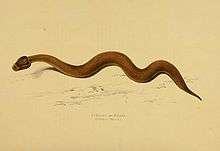Bitis inornata
Bitis inornata is a venomous viper species found only in Cape Province, South Africa.[2] No subspecies are currently recognized.[6]
| Bitis inornata | |
|---|---|
 | |
| Original illustration from A. Smith, 1838. | |
| Scientific classification | |
| Kingdom: | Animalia |
| Phylum: | Chordata |
| Class: | Reptilia |
| Order: | Squamata |
| Suborder: | Serpentes |
| Family: | Viperidae |
| Genus: | Bitis |
| Species: | B. inornata |
| Binomial name | |
| Bitis inornata (A. Smith, 1838) | |
| Synonyms[2] | |
Description
Adults of Bitis inornata average 25–40 cm (about 10–16 inches) in total length (including tail), with a maximum recorded total length of 45 cm (18 in).[3]
Geographic range
Bitis inornata is endemic to Cape Province, South Africa.
An isolated population exists on the Sneeuberg, eastern Cape Province, South Africa.[2]
The type locality is listed as "Sneeuwbergen, or Snow Mountains, ... immediately behind the village of Graaff Raynet" (Eastern Cape Province, South Africa).[2]
Spawls and Branch (1995) described it as known only from two isolated populations in southern Cape Province in South Africa: the first in the east, limited to the montane grassland of the Sneeuberge, from north of Graaff-Reinet to Cradock. A second population was discovered relatively recently on the upper slopes of the Cederberg in the west.[4]
Conservation status
The species Bitis inornata is classified as Data Deficient on the IUCN Red List.[7]
References
- Maritz, B., Tolley, K. & Turner, A.A. 2018. Bitis inornata. The IUCN Red List of Threatened Species 2018: e.T2817A115649282. https://dx.doi.org/10.2305/IUCN.UK.2018-2.RLTS.T2817A115649282.en. Downloaded on 20 December 2018.
- McDiarmid RW, Campbell JA, Touré T (1999). Snake Species of the World: A Taxonomic and Geographic Reference, Volume 1. Washington, District of Columbia: Herpetologists' League. 511 pp. ISBN 1-893777-00-6 (series). ISBN 1-893777-01-4 (volume).
- Mallow D, Ludwig D, Nilson G (2003). True Vipers: Natural History and Toxinology of Old World Vipers. Malabar, Florida: Krieger Publishing Company. 359 pp. ISBN 0-89464-877-2.
- Spawls, Stephen; Branch, Bill (1995). The Dangerous Snakes of Africa. Dubai: Oriental Press / Ralph Curtis Books. 192 pp. ISBN 0-88359-029-8.
- Brown JH (1973). Toxicology and Pharmacology of Venoms from Poisonous Snakes. Springfield, Illinois: Charles C. Thomas. 184 pp. LCCCN 73-229. ISBN 0-398-02808-7.
- "Bitis inornata ". Integrated Taxonomic Information System. Retrieved 26 July 2006.
- Bitis inornata at the IUCN Red List. Accessed 2 September 2007.
Further reading
- Boulenger GA (1896). Catalogue of the Snakes in the British Museum (Natural History). Volume III., Containing the ... Viperidæ. London: Trustees of the British Museum (Natural History). (Taylor and Francis, printers). xiv + 727 pp. + Plates I-XXV. (Bitis inornata, pp. 496–497).
- Branch, Bill (2004). Field Guide to Snakes and Other Reptiles of Southern Africa. Third Revised edition, Second impression. Sanibel Island, Florida: Ralph Curtis Books. 399 pp. ISBN 0-88359-042-5. (Bitis inornata, pp. 117–118 + Plate 14).
- Smith A (1838). Illustrations of the Zoology of South Africa; Consisting Chiefly of Figures and Descriptions of the Objects of Natural History Collected during an Expedition into the Interior of South Africa, in the Years 1834, 1835, and 1836; Fitted out by "The Cape of Good Hope Association for Exploring Central Africa:" Together with a Summary of African Zoology, and an Inquiry into the Geographical Ranges of Species in that Quarter of the Globe. [Volume III. Reptilia]. London: Lords Commissioners of her Majesty's Treasury. (Smith, Elder and Co., printers). 48 Plates + unnumbered pages of text. (Echidna inornata, new species, Plate 4 + two unnumbered pages).
External links
- Bitis inornata at the Reptarium.cz Reptile Database. Accessed 2 August 2007.
- Bitis inornata at Biodiversity.mongabay.com. Accessed 2 August 2007.
